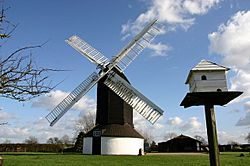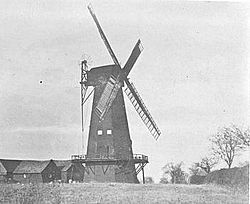Outwood Windmill facts for kids
Quick facts for kids Outwood post mill |
|
|---|---|

Outwood post mill
|
|
| Origin | |
| Mill name | Outwod post mill |
| Mill location | Outwood, Surrey |
| Grid reference | TQ 328 456 |
| Coordinates | 51°11′38″N 0°06′04″W / 51.194°N 0.101°W |
| Operator(s) | Private |
| Year built | 1665 |
| Information | |
| Purpose | Corn mill |
| Type | Post mill |
| Roundhouse storeys | Single storey roundhouse |
| No. of sails | Four sails |
| Type of sails | Spring sails |
| Windshaft | Wood, with cast iron poll end |
| Winding | Tailpole |
| No. of pairs of millstones | Two pairs, Head and Tail |
| Size of millstones | 4 feet (1.22 m) diameter |
The Outwood Windmill is a very old and important post mill located in Outwood, Surrey. It's so special that it's a Grade I listed site. Built way back in 1665 by Thomas Budgen, a miller from Nutfield, it holds the amazing title of being Britain's oldest working windmill.
This windmill wasn't alone! There was once another mill right next to it, a smock mill built in 1797. This second mill was actually the tallest smock tower in the whole United Kingdom. Sadly, it fell down in 1960.
Contents
History of Outwood Windmills
The Old Post Mill's Story
The Outwood Windmill was built for Thomas Budgen (1640–1716) in 1665. The original paper that allowed it to be built still exists today! Thomas Budgen borrowed money from his brothers-in-law to build the mill. He managed to pay them back in just two years.
It's said that the mill builders watched the Great Fire of London glowing in the distance. That fire was about 25 miles (40 km) away! In 1678, Thomas Budgen faced trouble for his religious beliefs. He was fined £20.
After Thomas Budgen passed away, his son John took over the mill. Later, the mill was owned by the Jupp family for many years. William Jupp ran it until he died in 1934. In 1929, experts recognized the mill as "super important."
New sails were needed in 1931. A group called the Society for the Protection of Ancient Buildings helped pay for them. They cost £80. William Jupp promised not to sell the mill to be torn down. This helped get more people interested in the mill. In 1933, another pair of sails was bought secondhand. These sails had been on another mill in Norfolk that was taken down.
Stanley Jupp took over the mill after William Jupp died. In the 1930s, the mill wasn't used much and started to get old. Plans to fix it were put on hold because of World War II. Milling stopped completely in 1949 when a main wooden beam cracked. This made the sails drop and touch the roof.
Temporary fixes were made, followed by big repairs in 1952. More repairs happened in 1955 when new sails were added. The government even gave £750 to help. In return, people could visit the mill by making an appointment. In 1962, the Thomas brothers bought the mill.
On June 12, 1964, a big thunderstorm hit the mill. The wind was pushing it from behind, which is dangerous. The new owners quickly turned the mill sideways to the wind, saving it from damage. In 2003, the mill was put up for sale for £600,000. On January 5, 2012, one of its sails was damaged in a strong wind.
The Smock Mill's History
| Outwood smock mill | |
|---|---|

The smock mill, c.1903. Note the missing fantail has been drawn in
|
|
| Origin | |
| Mill name | High Mill |
| Year built | 1796 |
| Information | |
| Purpose | Corn mill |
| Type | Smock mill |
| Storeys | Five-storey smock |
| Base storeys | Low brick base of a few courses |
| Smock sides | Eight sides |
| No. of sails | Four sails |
| Type of sails | Spring Patent sails |
| Windshaft | Cast iron |
| Winding | Fantail |
| No. of pairs of millstones | Four pairs |
| Year lost | 1960 |
| Other information | Tallest smock tower of any windmill in the United Kingdom |
On November 24, 1796, William Budgen was allowed to build another windmill. This one was on a piece of land near the first post mill. This second mill was a smock mill, sometimes called High Mill.
The smock mill was also run by the Budgen family until 1885. Then, Edward Scott bought the right to use the mill for £1,225. Later, Edward's son worked the mill. In 1903, one of its sails broke while it was working. It then worked with only two sails until 1914. Sometimes, a portable steam engine helped it grind grain.
In 1950, people wanted to save the smock mill. But a study in 1953 showed it was rotting and would cost too much to fix. Sadly, the mill collapsed in the early morning of November 25, 1960.
What the Windmills Looked Like
Outwood Post Mill: A Closer Look
The Outwood Mill is a post mill. This means its whole body can turn on a central post to face the wind. It sits on a round building called a roundhouse. It has four Spring sails. These sails use special springs to help them catch the wind.
The mill's main post is about 16-foot-3-inch (4.95 m) tall. The roundhouse walls are about 9 feet (2.74 m) high. The main body of the mill is about 18 feet (5.49 m) by 11 feet (3.35 m). The mill stands about 39 feet (11.89 m) tall to its roof. All the grinding machines are inside this main body. The body of the mill weighs about 25 long tons (25.4 t)!
Over the years, the mill has had different sails. The sails on the mill now stretch about 60 feet (18.29 m) wide. The mill uses two pairs of millstones to grind grain. One pair is called "Head" stones, and the other is "Tail" stones. The mill is turned to face the wind using a long pole called a tailpole.
Outwood Smock Mill: The Tall One
The Outwood Smock Mill, also known as High Mill, was a very tall smock mill. It had five floors and a platform on the first floor. It was built on a low brick base. The main wooden posts were about 48 feet (14.63 m) long. The mill stood about 62 feet (18.90 m) high to the top of its cap. This made it the tallest smock tower ever built!
The bottom of the smock mill was about 26 feet (7.92 m) wide. The top was narrower, about 13 feet (3.96 m) wide. The top part, called the cap, was turned by a five-bladed fantail. This fantail helped the cap face the wind.
The mill had four large sails called Spring Patents. These sails stretched about 80 feet (24.38 m) wide. Inside, the mill had a big wheel called the Brake Wheel, which was about 9-foot-10-inch (3.00 m) wide. This mill could grind grain using four pairs of millstones.
Visiting the Windmill
As of May 2013, it seems the Outwood Windmill is not open for public visits.
Millers of Outwood Windmills
Here are some of the people who worked as millers at the Outwood windmills:
Post Mill Millers
- Thomas Budgen 1665 – 1716
- John Budgen 1716 – 1765
- widow Budgen 1765 – 1768
- Ezekiel Budgen 1768 – ?
- John Jupp 1807 – ?
- William Jupp 1880 – 1934
- Stanley Jupp 1934 – 1962
- Gerald & Raymond Thomas 1962 – 1996
Smock Mill Millers
- William Budgen 1797 – ?
- Edward Scott 1885 – 1914

